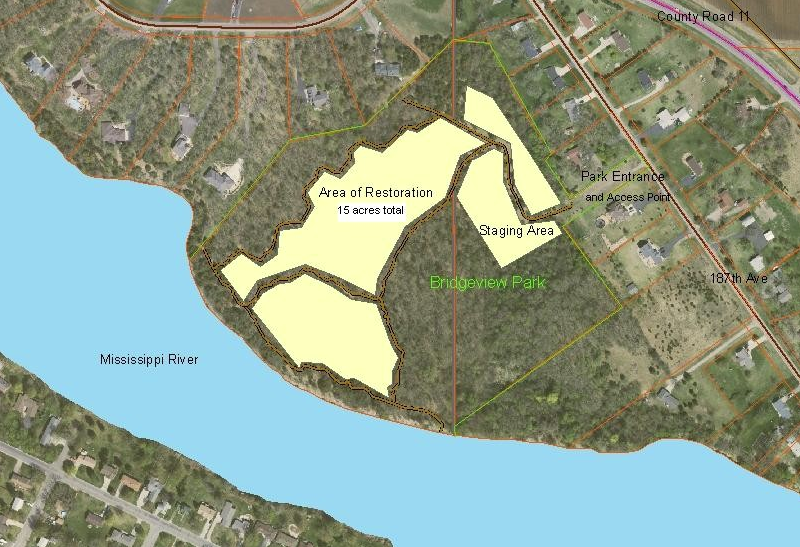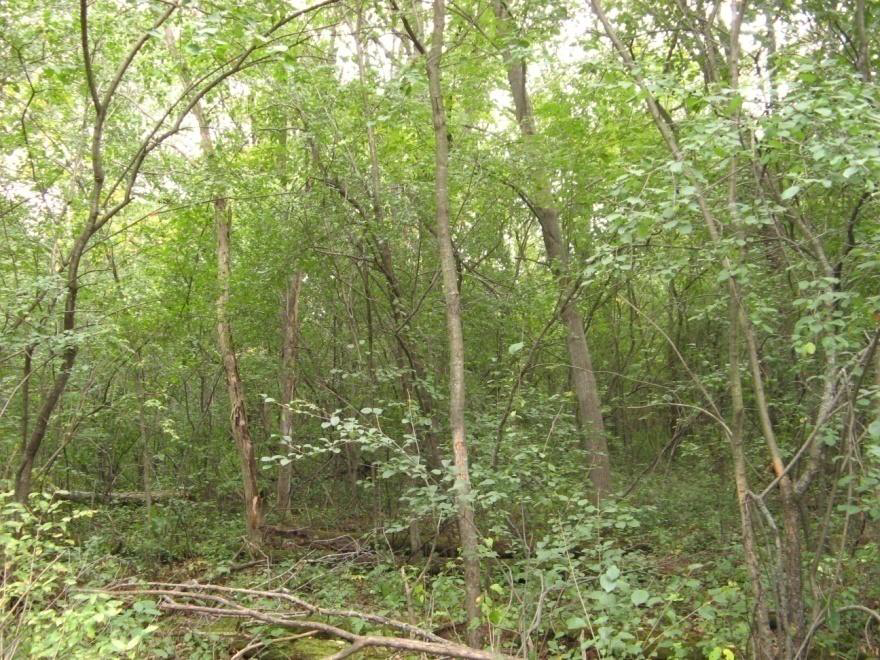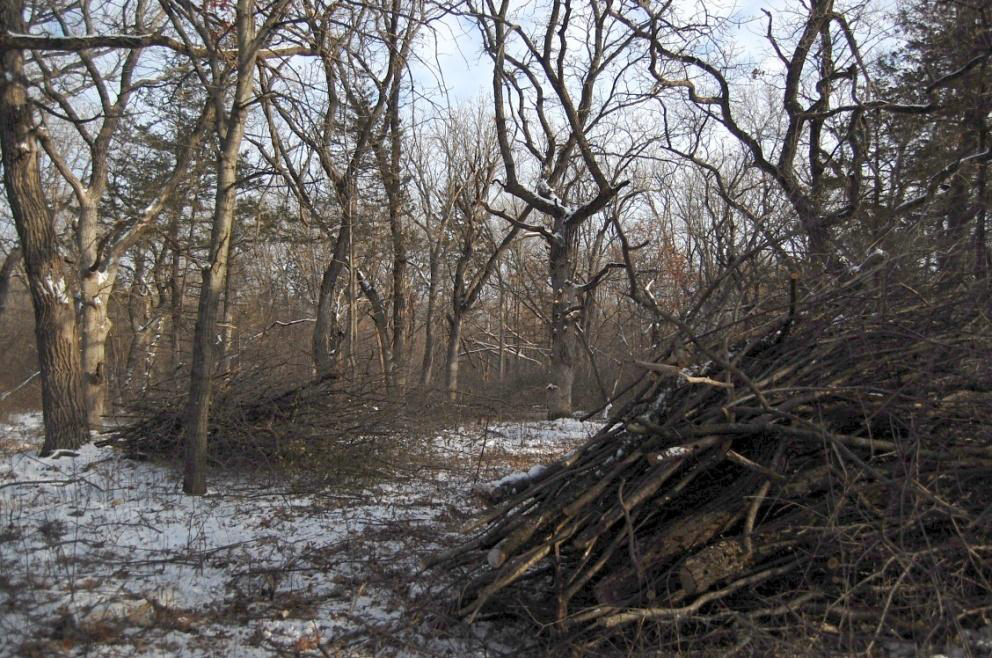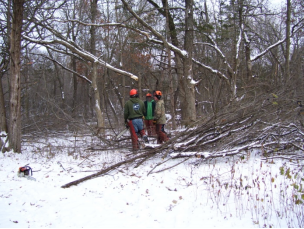Overview
The purpose of the DNR Woody Biomass Project, Linking Habitat Restoration to Bioenergy, is to utilize the conversion of woody biomass to bioenergy to create an economic incentive for the restoration of critical habitats that otherwise may not be restored, as well as to provide a local source of energy to the community. The removal of unwanted woody biomass (both native and non-native) will be performed on a variety of sites with different characteristics and restoration goals, and data will be used to create an information base to be used on future projects of a similar nature. The project was originally funded by a $500,000 legislative grant to the Department of Natural Resources. The DNR was later granted $600,000 from the Minnesota Environment and Natural Resources Trust Fund based on the success of the original project, $300,000 of which was disbursed to non-DNR public and private landowners on a competitive basis.
Sites have been selected within the constraints of a 75-mile distance from Saint Paul, each being ranked according to their ecological value and recovery potential. For practical purposes, the 75-mile radius for woody biomass procurement specified in the legislation will be measured from the Wood Recycling Center at 2165 Pigs Eye Lake Road, St. Paul, where woody material is collected and processed for use by District Energy St. Paul. More than 7,000 acres of potential area has been identified within this area for future woody biomass removal. Of the 15 sites used in the pilot project from 2008 to 2011, two have been selected for the Silviculture Library based on their dominant covertype of oak woodland/forest. This case study outlines the treatments carried out on the Bridgeview Park Reserve in Sherburne County.

Figure 1: Map of Bridgeview Park Reserve and the treatment area. Roughly half of the park was treated.
Silviculture Objective(s)
The purpose of this treatment in the Bridgeview Park Reserve was to restore oak woodland-brushland. The Bridgeview Park Reserve was created in 1999 utilizing grants from the DNR’s Natural and Scenic Areas grant program (matched by the adjacent developer) and the Central Minnesota Initiative Fund’s Scenic Area Land Preservation Program and is included in a large-scale Mississippi River corridor restoration effort. This project helped to implement the Sherburne County Management Plan for the Bridgeview Park Reserve dated May 2001, prepared by a team of experts.
Pre-treatment stand description and condition
Pre-treatment species composition:
The site is classified as an Oak Woodland-Brushland, having dry to dry-mesic woodlands and patchy canopy dominated by bur oak or northern pin oak. The site consists of densely stocked buckthorn of mature size and large diameter (4”-6” diameter). The buckthorn is scattered throughout the project site. Honeysuckle is also present, but at a lower density. The primary target species to be harvested will include buckthorn and honeysuckle but will also consist of eastern red cedar, aspen, cherry, and elm that are scattered throughout. The tree species are of various sizes but many have stem diameters between 6”-12”. Additional tree species present but which are less common include green ash, silver maple, red maple, and hackberry.

Figure 2: A before picture of the understory with prolific buckthorn.
Pre-treatment growth and stocking:
The overstory is dominated by bur oak, many of them large diameter (>25" dbh).
Pre-treatment forest health issues:
Buckthorn is the primary forest health threat, though honeysuckle is present as well.
Landowner objectives/situation:
The biomass project involves 15 acres involving the removal of buckthorn and other invasives, as well as the selective marking and removal of tree species. The primary goal is to initiate restoration of the site toward an oak woodland forest and/or oak savanna. Two of the priority actions to attain this goal will involve 1) control of the buckthorn and honeysuckle, which currently comprise much of the understory, and 2) selective removal of trees, including eastern red cedar, aspen, black cherry, elm, and perhaps some selective thinning of pin oak. The remaining half of the park will require the same restoration efforts being done here. Therefore, this project will encompass 15 acres and is the first step of many toward restoration of the park. As opportunities arise, the remaining acreage of the park will be addressed with similar restoration goals.
Silviculture Prescription
Harvest Goals: The preference or favoring of white oak over red oak; preference or favoring of large diameter tree species; maintaining some species diversity; obtaining a reduced density/greater spacing.
In addition to the general goals, additional principals will be followed to justify the thinning and marking process.
Control of Exotics and Invasives
- remove all buckthorn and honeysuckle
Reduce Density
- improve forest health and reduce competition
- provide improved spacing of oak resulting in 10 to 30 trees per acre.
Disease Resistance
- elm (cut to reduce risk of Dutch Elm Disease and reduce seeding)
- oak (reduce risk of Oak Wilt by favoring white oak, thinning red oak)
- ash (cut to reduce risk of potential Emerald Ash Borer)
Fire Resistance
- favor white oak for its ability to withstand future prescribed burning
- thin or limb cedar to allow for future prescribed burning
Public Safety
- remove hazard trees and trees with broken tops, lean, and poor form
Significant Trees
- protect large diameter trees in good condition
Age Class Diversity
- as feasible, leave some younger, understory trees
What actually happened during the treatment
Sherburne County contracted with Prairie Restorations, Inc. that utilized Sentencing to Service crews for the hand-cutting and stump treatment, and Tree Top Services for mechanized cutting and skidding. The treatment began in fall 2008 and was finished in January 2009.
Biomass volume: 23 loads, 1,840 cy; 460 tons.
October 2009: Buckthorn education night at Bridgeview, educating residents about the project, the ecological threat that buckthorn poses and keys to successful removal and control.
Fall 2009: Prescribed burn.
Summer 2010: Mechanical removal (pulling) of common mullein, which was not affected by the burn, and cutting of buckthorn resprouts.
Late spring 2011: Prescribed burn.
Late summer 2011: Cutting of buckthorn resprouts.
Fall 2011: Dormant wick application of herbicide applied to foliage of buckthorn resprouts cut in late summer 2011.
January-February 2012: Untreated buckthorn, some as high as 6', were cut.
Summer 2012: All buckthorn was cut over the entire 15 acre treatment area.
May 2013: Prescribed burn. Achieved good control of existing buckthorn stems.
October 2013: Dormant overspray application.
No further work was needed following 2013, but invasive species began to surface including common tansy, Canada thistle, and garlic mustard. Spot treatments have been conducted annually on tansy and thistle to the present day, while garlic mustard has been pulled at bolting/blooming and appears to be under control. Critical period cutting of buckthorn has continued to keep it from producing seed and vulnerable to either dormant wick application with bark penetrant or fire.
In 2016-2017 buckthorn was removed on the other half of the park which was not part of the original treatment. In addition to the buckthorn, a thin was carried out which targeted all red cedar and some trees crowding open-grown bur oaks. This action took place on frozen ground with some snow cover.
Fall 2017: Dormant foliar overspray of entire 30 acre area.
Spring 2019: Prescribed burn.
July 2019: Critical period cutting of dense shrub areas, targeting the following species: raspberries, blackberries, honeysuckle, buckthorn, American hazel, chokecherry, prickly ash, and quaking aspen. Some species are native but interfere with prescribed burning.

Figure 3: The treatment area after the buckthorn removal.
Post-treatment assessment
While it is labor intensive and expensive, the cutting and stump treatment method for controlling buckthorn was a success. However, buckthorn control is not a singular event but rather requires multiple iterations and careful observation of how the system responds to determine the most effective way to control it. As management activity showed, the buckthorn removal carried out through a partnership with the MN DNR was only the first step.
Current stand conditions as of summer 2019 have an abundance of varied ground vegetation compared to prolific buckthorn and other invasives in the understory prior to the initial buckthorn control and subsequent management activity.
Costs and economic considerations
Table 1: Cost data for the project.
| Acres Harvested | Project Funds | Cost per Acre | Tons | Cost per Ton |
| 15 | $30,784 | $2,052 | 460 | $66.92 |
The Department of Natural Resources, Division of Ecological Resources (DNR) received a one-time appropriation of $500,000 from the MN legislature as part of the 2007 environment, natural resources, energy, and commerce finance bill. Citation: Laws of 2007, Chapter 57, Article 2, Sec. 3, subd. 6.
Legal Citation: M.L. 2012, Chap. 272, Sec. 85
Appropriation Language: Laws of Minnesota 2010, Chap. 362, Sec. 2, Subd. 7c as amended by M.L. 2012, Chap. 272, Sec. 85.
$600,000 is from the trust fund to the commissioner of natural resources to restore high quality native habitats and expand market opportunities for using the woody by-product material for bioenergy source or other products.
Other notes
This case study was developed with support from the United States Department of Agriculture's National Institute for Food and Agriculture (USDA-NIFA), Renewable Resources Extension Act (RREA). Project #MIN-44-E02, principal investigator Eli Sagor, University of Minnesota.
Summary / lessons learned / additional thoughts
Overall, this project addresses both the need for restoration of critical habitat and the potential for the use of bioenergy in local communities. Buckthorn will be an ongoing forest health issue and its removal is often necessary for the maintenance and restoration of various habitat types. One benefit of this project was connecting land managers and habitat/ecosystem restoration contractors to energy producers. If invasive or ecologically inappropriate biomass must be removed, and if it is viable, it makes more sense to find a productive use for that biomass such as bioenergy than to simply let it go to waste. Hopefully this project sets a precedent for the future by making ecosystem restoration goals more attainable to land managers through the sale of biomass. Continuing to work along the lines of this project toward more financially self-sustaining projects could lead to benefits both in site ecology and in community energy production in Minnesota and elsewhere.
This project also shows that buckthorn management is a constant battle and cannot be accomplished in a single treatment. While the initial treatment was comprehensive, follow-up spot treatments are necessary for the foreseeable future as new seed will continue to come in and if there is a lull in treatments buckthorn may make a resurgence. This requirement for continued management means costs can be prohibitively high but this treatment is viable and effective on high priority sites, restoring this forest covertype to a normal system function.
